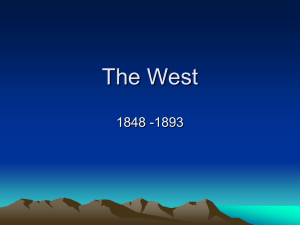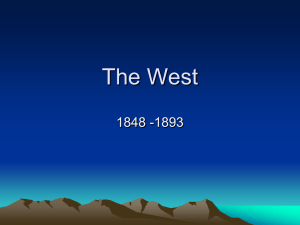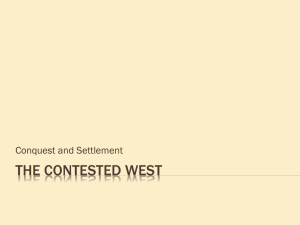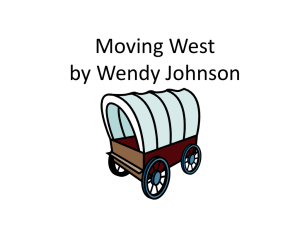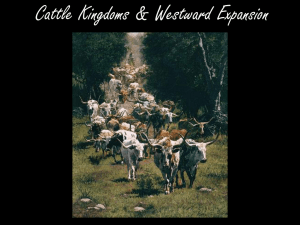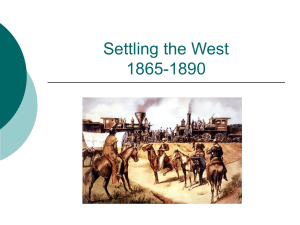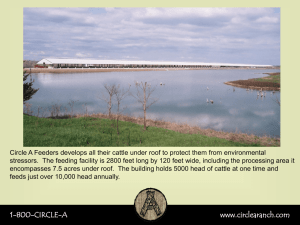The Cattle Kingdom and Farming the Great Plains
advertisement
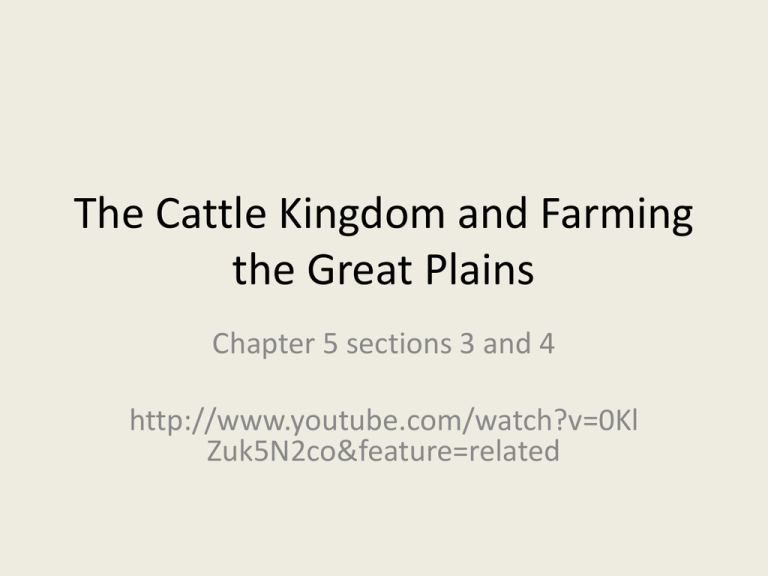
The Cattle Kingdom and Farming the Great Plains Chapter 5 sections 3 and 4 http://www.youtube.com/watch?v=0Kl Zuk5N2co&feature=related The Cattle Boom “Cattle are permitted to range… over a large surface of country, thirty, forty, and even fifty miles in extend [size].” Who is going to keep track of these cattle? The Cattle Boom • ___________ _____________ are a mix between Spanish and English cattle breeds. – Breed spreads quickly throughout Texas – They were lean and tough – Had horns up to ____ feet across – Need little ___________ and can survive the harsh weather. The demand for beef • Following the _____________ War, the demand for beef increases drastically. – Growing ________________ and increasing _________________ – Cattle that were $3 in Texas would sell for upwards of ________in New York! • Joseph McCoy establishes a market where cattle were shipped on the _______________ ____________ ______________. The Cattle Kingdom • ________________ expands onto the Great Plains • Ranches are built and cattle is taken to Colorado, Wyoming, Nebraska, and ___________________ • This area comes to be known as the _______________ ________________. • In this area, ranchers graze their herds on public lands called the open range. The Ranches • ______________ _______________– Became extremely wealthy during this time period when she switched from mining to ranching • Some ranches in Texas today are over 3 million acres! That is bigger than the size of _______________ ________________! Range Rights • Ranchers had to be concerned with securing ____________ for their cattle. • ____________ _____________, or water rights, to ponds and rivers were bought by ranchers that allowed them to secure scarce water sources as well as the land around it. • Ranchers could cut out their ___________________ by stopping other ranchers and farmers from using water. Wild West Rootin Shootin Cowboy Dictionary • Find your 8 o’ clock pardner!!! • You have 5 minutes! • Match the definition with its correct term by robbin’ that thar word down yonder. • Good luck, Pardner!!! The Cowboys • The workers who took care of the ranchers cattle were called _______________. – They learned many farming and herding techniques from Mexican ___________________. • Mexican ranch hands who cared for cattle and _____________ – – – – – Western saddle The _______________(a rope used for lassoing cattle) Leather chaps Broad felt hats Bandanas Cowboys • Gathering cattle together was known as ________________. – Each cow was branded with a unique mark to prevent cattle theft • Cowboys faced multiple ______________ – Cattle thieves, bad weather, unpredictable cattle, Cattle Drives and Cattle Towns • The ____________ ____________ was a long journey where cowboys herded cattle to the market or to the northern Plains to graze. • The ______________ _____________was one of the earliest and most popular routes for cattle drives. – Ran from San Antonio, Texas to __________, Kansas The end of the open range • The __________________ railroad car allowed meat to be carried from packing plants to eastern cities. • ________ _______ allowed farmers to cheaply fence off their land. Range wars • With the use of barbed wire, large ranchers moved quickly to fence in the open range and secure the water sources. • Farmers and small ranchers cut the fences and moved onto the land in response, creating _________ ______. End of the open range 2 • _____________ owners begin to compete for the land – Sheep chew grass down very low • 1885 and 1886 saw terrible winters in the Midwest. – Cattle die due to lack of food – _______________ drops the price of cattle – Harsh weather kills cattle – Greater competition for grazing land Cowboys today • http://app.discoveryeducation.com/search#se lItemsPerPage=20&intCurrentPage=1&No=20 &N=0&Ne=&Ntt=cowboys&Ns=&Nr=&browse Filter=&indexVersion=&Ntk= • The Homestead Act • 160 FREE ACRES OF LAND!!! • All you have to do is move to it!!! Farming the Great Plains • In 1862, Congress passed two important land – grant acts that helped to open up the West for settlers to move. • The _________________ __________ gave government – owned land to small farmers. – ______acres of land – Homesteaders paid a small registration fee – Must live on the land for ____ years The Morrill Act • Granted more than 17 million acres of federal land to the states. • Required states to use the revenue from selling this land to build ____________ (Texas A & M) to teach agriculture and engineering. Land Rushes and Staking their claims • The Federal government offered land and opened up 11 million acres in Oklahoma for people to stake their claims. • _____________ people rushed to Oklahoma for land. • Far and Away – http://www.youtube.com/watch?v=yxaJY8UZxn4 Settling the Plains • The Homestead Act granted land not just to white males. – __________________ – Immigrants from ________________ – ______________ ______________from the south • ___________________– because of their exodus, or mass departure, from the South. • Wanted better _____________ opportunities and ___________ _____________ Exodusters • “I one day said to the man I rented [land] from: “It’s no use, I works hard and raises big crops and you sells it and keeps the money, and brings me more and more in debt, so I will go somewhere else.” – John Solomon Lewis quoted in Exodusters: Black Migration to Kansas after Reconstruction, by Nell Irvin Painter Farming on the Plains • Inexpensive, but had many unique challenges – Extreme seasons • -40 degrees in winter • 110 degrees in summer – Dry climate – Deep rooted, ____________ land – Threat of blizzards and extreme _____________ Adaptation • Farmers survived by developing new farm equipment and methods • _________ __________ developed the deep steel plow • The hard work of breaking up the sod earned the farmers on the plains the nickname __________________. Dry farming • ___________ ____________ shifted the focus from water dependent crops to hardier crops. – Shift from corn to things such as wheat – Rotated crops and left certain farm land _____________ to preserve soil and water in the fields Cyrus McCormick • In the 1880’s mechanical farming became increasingly common. • Made farming much more efficient – Great Plains became known as the “_________________” of the world. • Cyrus McCormick designed, built, and sold farm equipment. – Reapers – Threshing machines Daily Life on the Plains • “When one begins to farm, it takes a great deal of to get started – especially when one must begin with nothing.” – Settlers had to make and mend their own clothing – No ______________ machines – Wash soap made from lye – Building a house • Very little ___________ available • Homes built out of brick and sod Family Life • ______________ prepared meals and often grew the vegetables for the family to eat. – Also raised ______________ and made butter to earn extra money for the family • Raised livestock, plowed and planted the fields • Pioneers had to build their own farm buildings and repair their own machinery. • Farm families were often very large and the ______________ helped on the farm. Communities on the Great Plains • Because of the isolated and lonely life of farming on the plains, farmers formed ___________to support one another. • Established a local church and school Schools on the Great Plains • Pioneer schools – Often built by and run by community • Most teachers were young ________________ – __________room buildings with a _____________ in the middle of the room – Children from all grades attended – Most students only went to school only part of year to help ____________ Sitting Bull • Vision of soldiers falling into camp was interpreted by the Sioux that they would defeat the white soldiers at Little Big Horn • Killed in 1890 by Sioux Indian Reservation police • Chief and medicine man of the Hunkpapa Lakota Group Jesse James • Train Robber and Bank Robber • Married his first cousin, Zerelda • So sought after that detectives stalked his mother and threw a bomb into her cabin, killing his half – brother Wild Bill Hickock • James Butler is his real name • Buried next to Calamity Jane • Dead Man’s hand because he was shot and killed while playing poker • Always carried a pair of pearl-handled pistols Geronimo • Apache chief and medicine man • Twice captured by Army generals • Led the Apache armed resistance • Took 5,000 U.S. soldiers and 500 Apache scouts to capture him Crazy Horse • War leader of the Sioux who led the Indian forces at the Battle of Little Bighorn • Was stabbed to death when he tried to escape capture • Led an ambush in 1866, killing 81 cavalry George Armstrong Custer • Infamous “last stand” at the Battle of Little Bighorn • “Battle of Greasy Grass” • Civil War Hero • Wrote a book, “My Life on the Plains” Annie Oakley • Historic character behind the Broadway musical, “Annie Get your Gun” • Known for amazing speed and accuracy with rifles and pistols • Could hit a dime in midair from 90 feet Buffalo Bill Cody • William • Supplied buffalo meet for workers on the Kansas Pacific Railroad – 1867 – 15,000,000 – 1890 – 600 • Helped shape the worlds romantic image of the west Butch Cassidy • Most famous partner was Sundance Kid • Earned his nickname as being a meat-cutter • Was portrayed by Paul Newman in a film bearing his name • Hideout was at Hold-inthe-Wall in Diamond Mountains, CO • Voted whether or not to kill guards and bankers Billy the Kid • Killed 21 men during his 21 year life • Escaped from a New Mexico jail twice • Killed a man with a pen knife when 14 years old • Fast draw and short temper • Bank and train robber
